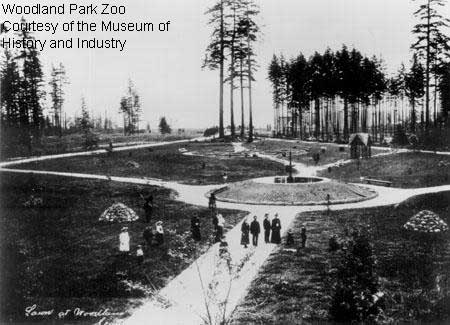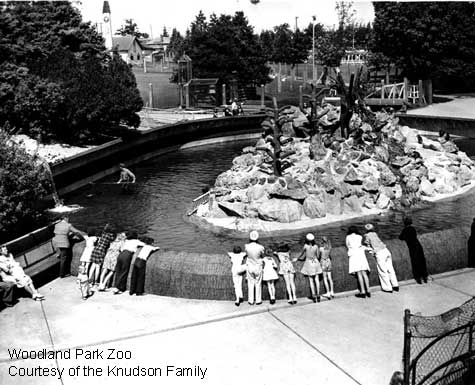ZOO HISTORY
A short history of a community tradition since 1899
IT ALL STARTED WHEN
Guy Phinney was English by birth and invested $40,000 in his estate to develop a traditional English park on his acreage on the shores of Seattle's Greenlake. He built a large house and laid out a formal rose garden, constructed a pump house to bring water from Greenlake to his gardens, erected an impressive stone entrance on 50th Avenue, and installed an electric trolley line along Fremont Avenue for his private street car. The aristocratic tradition also demanded a deer park and by 1893, when Phinney died, a small herd had been established in the park.

Woodland Park Zoo around 1900-1910s
The first zoo in Seattle was a small collection of animals owned by the Lake Washington Cable Railway and maintained at Leschi Park. Their animals were given to the City soon after they purchased Woodland Park, and it is interesting to note that Carkeek Park’s first use was as a vegetable garden for the zoo animals.
The City fathers engaged the famous Massachusetts landscape architectural firm of the Olmsted Brothers to create a public park out of Guy Phinney’s estate. The choice was apt since the work of the Olmsted office, which included Central Park in New York City, was an inspired outgrowth of the English landscape tradition.
They retained the formal gardens of the Phinney estate, laid out new pathways, and created several great spaces with animal quarters on the periphery, after the fashion of the day. Lower Woodland was left as an informal woods, but in 1930 City Engineer W.B. Barkuff developed a plan to bisect Woodland Park with a six-lane highway. Councilman George Hill, who had earlier taken City Engineer R.H. Thompson on a tour of Europe to “cure him of the habit of putting roads through parks,” formed a coalition to defeat the highway plan and proposed an alternate route following the contours of the land. Despite a public referendum vote against the plan, Aurora Avenue was constructed and the park was divided.
Since that time Woodland Park Zoo has remained in “Upper” Woodland Park. During the Depression several WPA projects were built, including a commissary, beaver ponds and monkey island. In 1949, under the direction of Zoo Director Ed Johnson, the bear and feline grottos were designed. He also proposed a children’s zoo at that time, but not until 20 years and five unsuccessful Park Bonds later, plus a controversy over theme design, was the first unit of the children’s zoo opened in 1967.
The 1968 Forward Thrust Bond Issue provided $4.5 million for a list of specific zoo improvements. They were to be developed in accordance with a “comprehensive plan,” and since no such plan existed, the city hired architect G.R. Bartholick to develop long-range proposals. His plan called for the extension of the zoo into Lower Woodland Park using a 700-foot zoological conservatory over Aurora Avenue to reunite the park. Paradoxically a public initiative defeated this innovative proposal in November 1974.

"Monkey Island" a 1930s Works Progress Administration project. It was later the basis for "Lemur Island", a naturalistic exhibit in our Tropical Rain Forest biome.
Seattle Mayor Wes Uhlman then appointed a zoo advisory committee to establish guidelines for a new direction, and in the late spring of 1975 work began on a new plan under the direction of David Hancocks as design coordinator. Jones & Jones was hired that fall, and approval for their comprehensive plan was given by the City Council early in 1976. The 1976 Long-Range Plan was the zoo’s first master plan. It established new circulation, landscaping and land use criteria organized around an ecological approach to zoo design. Forward Thrust development was at last ready to begin. First on-site work started in the summer of 1976 with a schedule calling for completion by the end of 1979. During that time the African Savanna, Gorilla Exhibit, Primate Islands, and North American Marsh and Swamp exhibits were created.
The 1985 Zoo Bond Issue provided $31.5 million and private donations in response to the “Save Our Elephants” campaign and the efforts of the Woodland Park Zoological Society raised an additional $10 million from private donations to match the bond and to build additional elements of the 1976 Long-Range Plan. The Asian Elephant Forest exhibit, Tropical Rain Forest exhibit, Education Center, ZooStore, Animal Health Complex, Northern Trail exhibit and Trail of Vines exhibit were constructed between 1987 and 1996.
On March 1, 2002, the City of Seattle, acting through its Department of Parks and Recreation, entered into an Operations and Management Agreement for the zoo with Woodland Park Zoological Society.
In addition to assuming the responsibility for operations and management, Woodland Park Zoological Society raised private donations to fund the African Village opened in 2001, Jaguar Cove exhibit opened in 2003, the historic carousel and Zoomazium in 2006, the Humboldt penguin exhibit in 2009, and Banyan Wilds opened in 2015.
- Excerpted in part from Woodland Park Zoo's 2004 Long-Range Physical Development Plan